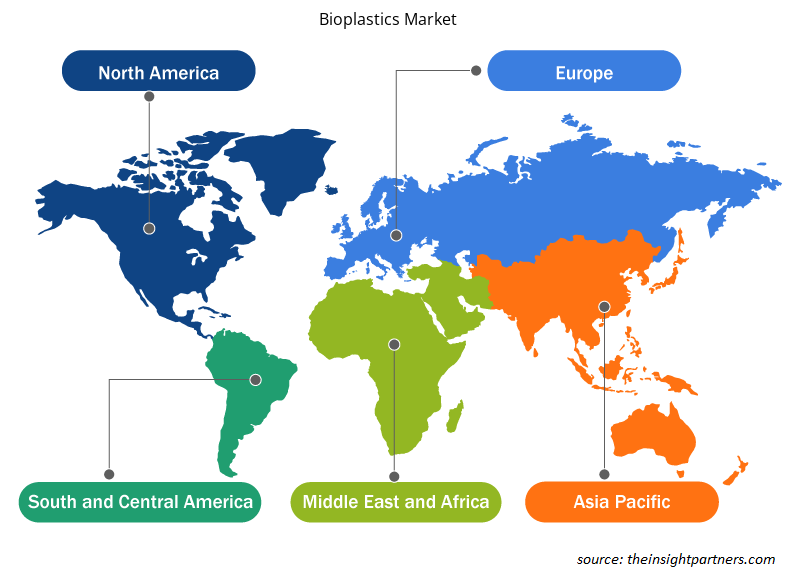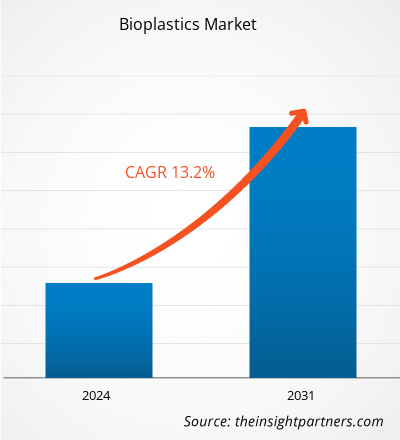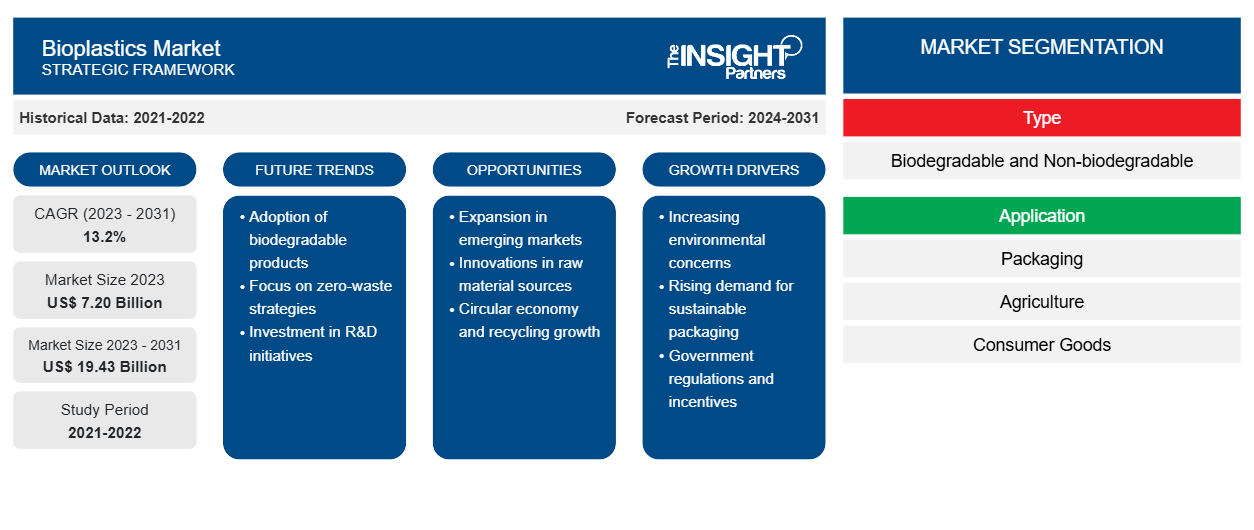Der Markt für Biokunststoffe soll von 7,20 Milliarden US-Dollar im Jahr 2023 auf 19,43 Milliarden US-Dollar im Jahr 2031 anwachsen. Der Markt wird voraussichtlich zwischen 2023 und 2031 eine durchschnittliche jährliche Wachstumsrate (CAGR) von 13,2 % verzeichnen. Der zunehmende Fokus auf Innovation und technologischen Fortschritt dürfte auch weiterhin die wichtigsten Trends auf dem Biokunststoffmarkt bleiben.
Biokunststoffe Marktanalyse
Die wachsenden Umweltbedenken und das globale Bestreben, die Umweltverschmutzung zu verringern, treiben die Nachfrage nach biologisch abbaubaren Kunststoffen im Verpackungssektor weltweit an. Darüber hinaus wird erwartet, dass die Nachfrage nach Biokunststoffen in der Verpackungsindustrie aufgrund des steigenden Bedarfs an verschiedenen Gesundheitsprodukten steigen wird. Darüber hinaus ist es für Hersteller einfach, Verpackungen aus Biokunststoffen herzustellen, da Verpackungen aus Biopolymeren normalerweise mit Standardtechnologie zur Kunststoffverarbeitung hergestellt werden können. Die wachsende Nachfrage nach umweltfreundlichen Kunststoffen im Verpackungssektor ist ein wichtiger Faktor, der das Wachstum des Biokunststoffmarktes weltweit im Prognosezeitraum ankurbeln dürfte.
Marktübersicht für Biokunststoffe
Biokunststoffe sind Kunststoffe, die aus erneuerbaren Biomassequellen bestehen, darunter pflanzliche Fette und Öle, Maisstärke, Stroh, Holzspäne, Sägemehl und recycelte Lebensmittelabfälle. Biokunststoffe werden zunehmend eingesetzt, um das Problem des Plastikmülls zu reduzieren, der den Planeten erstickt und die Umwelt verschmutzt . Darüber hinaus erfordert die Herstellung von Biokunststoffen 65 % weniger Energie als herkömmliche Erdölkunststoffe.
Passen Sie diesen Bericht Ihren Anforderungen an
Sie erhalten kostenlose Anpassungen an jedem Bericht, einschließlich Teilen dieses Berichts oder einer Analyse auf Länderebene, eines Excel-Datenpakets sowie tolle Angebote und Rabatte für Start-ups und Universitäten.
-
Holen Sie sich die wichtigsten Markttrends aus diesem Bericht.Dieses KOSTENLOSE Beispiel umfasst eine Datenanalyse von Markttrends bis hin zu Schätzungen und Prognosen.
Treiber und Chancen auf dem Biokunststoffmarkt
Steigende Nachfrage nach Biokunststoffen in verschiedenen Anwendungsbereichen
Die steigende Nachfrage nach Biokunststoffen in verschiedenen Anwendungsbereichen ist ein wichtiger Treiber für den Biokunststoffmarkt. Biokunststoffe werden in zahlreichen Endverbrauchsbranchen wie Medizin, Automobil und Transport, Verpackung, Landwirtschaft, Konsumgüter, Textilien, Bauwesen und anderen eingesetzt. Im medizinischen Bereich finden Biokunststoffe umfassende Anwendung in der Wundversorgung, Gewebezüchtung, Arzneimittelverabreichung, orthopädischen Geräten und der Herstellung von faserigen und porösen Gerüsten. Im Automobilbereich sorgen Biokunststoffe für eine geringere Abhängigkeit von fossilen Ressourcen, geringere Herstellungskosten und einen deutlich geringeren CO2-Fußabdruck. Darüber hinaus werden Biokunststoffe für die starre Verpackung von Kosmetika wie Kompaktpuder, Cremes, Lippenstiften und Getränkeflaschen verwendet .
Strenge staatliche Gesetze und Vorschriften zur Verwendung herkömmlicher Kunststoffe
Zahlreiche Länder auf der ganzen Welt haben Gesetze und Vorschriften zum Thema Kunststoff erlassen. Verschiedene Länder unternehmen Anstrengungen, um Einwegkunststoffe zu verbieten und nachhaltige Alternativen zu fördern. Dies wird dazu beitragen, die negativen Auswirkungen auf das menschliche Leben und die Umwelt zu mildern. Daher ist zu erwarten, dass die strengen staatlichen Gesetze und Vorschriften zur Verwendung herkömmlicher Kunststoffe lukrativere Möglichkeiten für das Wachstum des Biokunststoffmarktes bieten.
Segmentierungsanalyse des Biokunststoffmarktberichts
Schlüsselsegmente, die zur Ableitung der Biokunststoffmarktanalyse beigetragen haben, sind Typ und Anwendung.
- Je nach Typ ist der Markt in biologisch abbaubar und nicht biologisch abbaubar unterteilt. Das biologisch abbaubare Segment hatte im Jahr 2023 einen größeren Marktanteil.
- Nach Anwendung ist der Markt in Verpackung, Landwirtschaft, Konsumgüter, Automobil und Transport, Textilien, Bauwesen und andere unterteilt. Das Verpackungssegment hielt im Jahr 2023 den größten Marktanteil.
Biokunststoffe Marktanteilsanalyse nach Geografie
Der geografische Umfang des Biokunststoffmarktberichts ist hauptsächlich in fünf Regionen unterteilt: Nordamerika, Asien-Pazifik, Europa, Naher Osten und Afrika sowie Süd- und Mittelamerika.
Der globale Markt wurde von Asien-Pazifik dominiert. Europa ist ein zweiter großer Anteilseigner des globalen Biokunststoffmarktes. In Nordamerika werden Biokunststoffe in der Verpackungsbranche in Form von Plastikflaschen und -tüten häufig verwendet. Produktion und Verbrauch von Biokunststoffen werden in der Region voraussichtlich wachsen, vor allem bei Lebensmittelverpackungen. Im Gegensatz zu herkömmlichen Kunststoffen werden Biokunststoffe aus erneuerbaren Quellen gewonnen. Die Automobilindustrie in dieser Region ist aufgrund erheblicher Investitionen in Infrastruktur, F&E-Aktivitäten und neue Produktionsanlagen eine der fortschrittlichsten Branchen weltweit. Biopolyamide (Bio-PA), Polymilchsäure (PLA) und biobasiertes Polypropylen (Bio-PP) sind Biokunststoffe, die im Automobilbau häufig verwendet werden. Diese Faktoren treiben das Wachstum des Marktes für Biokunststoffe im Automobilbereich voran.
Regionale Einblicke in den Biokunststoffmarkt
Die regionalen Trends und Faktoren, die den Biokunststoffmarkt im Prognosezeitraum beeinflussen, wurden von den Analysten von Insight Partners ausführlich erläutert. In diesem Abschnitt werden auch die Marktsegmente und die geografische Lage des Biokunststoffmarkts in Nordamerika, Europa, im asiatisch-pazifischen Raum, im Nahen Osten und Afrika sowie in Süd- und Mittelamerika erörtert.

- Holen Sie sich die regionalen Daten für den Biokunststoffmarkt
Umfang des Marktberichts über Biokunststoffe
| Berichtsattribut | Details |
|---|---|
| Marktgröße im Jahr 2023 | 7,20 Milliarden US-Dollar |
| Marktgröße bis 2031 | 19,43 Milliarden US-Dollar |
| Globale CAGR (2023 - 2031) | 13,2 % |
| Historische Daten | 2021-2022 |
| Prognosezeitraum | 2024–2031 |
| Abgedeckte Segmente |
Nach Typ
|
| Abgedeckte Regionen und Länder |
Nordamerika
|
| Marktführer und wichtige Unternehmensprofile |
|
Marktdichte von Biokunststoffen: Auswirkungen auf die Geschäftsdynamik
Der Markt für Biokunststoffe wächst rasant, angetrieben durch die steigende Nachfrage der Endverbraucher aufgrund von Faktoren wie sich entwickelnden Verbraucherpräferenzen, technologischen Fortschritten und einem größeren Bewusstsein für die Vorteile des Produkts. Mit der steigenden Nachfrage erweitern Unternehmen ihr Angebot, entwickeln Innovationen, um die Bedürfnisse der Verbraucher zu erfüllen, und nutzen neue Trends, was das Marktwachstum weiter ankurbelt.
Die Marktteilnehmerdichte bezieht sich auf die Verteilung von Firmen oder Unternehmen, die in einem bestimmten Markt oder einer bestimmten Branche tätig sind. Sie gibt an, wie viele Wettbewerber (Marktteilnehmer) in einem bestimmten Marktraum im Verhältnis zu seiner Größe oder seinem gesamten Marktwert präsent sind.
Die wichtigsten auf dem Biokunststoffmarkt tätigen Unternehmen sind:
- Teijin Limited
- Toray Industries, Inc.
- Sabic
- BASF SE
- Gesamtcorbion PLA
- Braskem SA
Haftungsausschluss : Die oben aufgeführten Unternehmen sind nicht in einer bestimmten Reihenfolge aufgeführt.

- Überblick über die wichtigsten Akteure auf dem Biokunststoffmarkt
Neuigkeiten und aktuelle Entwicklungen zum Biokunststoffmarkt
Der Biokunststoffmarkt wird durch die Erhebung qualitativer und quantitativer Daten nach Primär- und Sekundärforschung bewertet, die wichtige Unternehmensveröffentlichungen, Verbandsdaten und Datenbanken umfasst. Im Folgenden finden Sie eine Liste der Entwicklungen auf dem Markt für Sprach- und Sprechstörungen sowie Strategien:
- SABIC, ein weltweit führendes Unternehmen der chemischen Industrie, hat heute ein neues Portfolio biobasierter ULTEM™-Harze auf den Markt gebracht, die Nachhaltigkeitsvorteile bieten und gleichzeitig genau die gleiche hohe Leistung und Verarbeitbarkeit wie die bisherigen ULTEM-Materialien aufweisen. Diese bahnbrechenden Polyetherimid-Materialien (PEI) sind die ersten zertifizierten erneuerbaren, leistungsstarken, amorphen Polymere, die in der Branche erhältlich sind. (Quelle: SABIC, News and Media/Latest News/Oktober 2021)
- Toray Industries, Inc. gab heute bekannt, dass es eine Nylon-510-Faser (N510) entwickelt hat, die zu 100 % aus „biobasiertem synthetischem Polymer“ besteht, wie in Abschnitt 3.1.5 der ISO 16620-1:2015, der internationalen Norm für den biobasierten Anteil von Kunststoffen, definiert. Ecodear N510 wird die erste 100 % pflanzenbasierte Nylonfaser in Torays Ecodear-Reihe sein. (Quelle: TORAY INDUSTRIES, INC., Newsroom/ Januar 2022)
Marktbericht zu Biokunststoffen – Umfang und Ergebnisse
Der Bericht „Marktgröße und Prognose für Biokunststoffe (2021–2031)“ bietet eine detaillierte Analyse des Marktes, die die folgenden Bereiche abdeckt:
- Marktgröße und Prognose auf globaler, regionaler und Länderebene für alle wichtigen Marktsegmente, die im Rahmen des Projekts abgedeckt sind
- Marktdynamik wie Treiber, Beschränkungen und wichtige Chancen
- Wichtige Zukunftstrends
- Detaillierte Porter's Five Forces und SWOT-Analyse
- Globale und regionale Marktanalyse mit wichtigen Markttrends, wichtigen Akteuren, Vorschriften und aktuellen Marktentwicklungen
- Branchenlandschaft und Wettbewerbsanalyse, einschließlich Marktkonzentration, Heatmap-Analyse, prominenten Akteuren und aktuellen Entwicklungen
- Detaillierte Firmenprofile
- Historische Analyse (2 Jahre), Basisjahr, Prognose (7 Jahre) mit CAGR
- PEST- und SWOT-Analyse
- Marktgröße Wert/Volumen – Global, Regional, Land
- Branchen- und Wettbewerbslandschaft
- Excel-Datensatz
Aktuelle Berichte
Verwandte Berichte
Erfahrungsberichte
Grund zum Kauf
- Fundierte Entscheidungsfindung
- Marktdynamik verstehen
- Wettbewerbsanalyse
- Kundeneinblicke
- Marktprognosen
- Risikominimierung
- Strategische Planung
- Investitionsbegründung
- Identifizierung neuer Märkte
- Verbesserung von Marketingstrategien
- Steigerung der Betriebseffizienz
- Anpassung an regulatorische Trends























 Kostenlose Probe anfordern für - Biokunststoffmarkt
Kostenlose Probe anfordern für - Biokunststoffmarkt